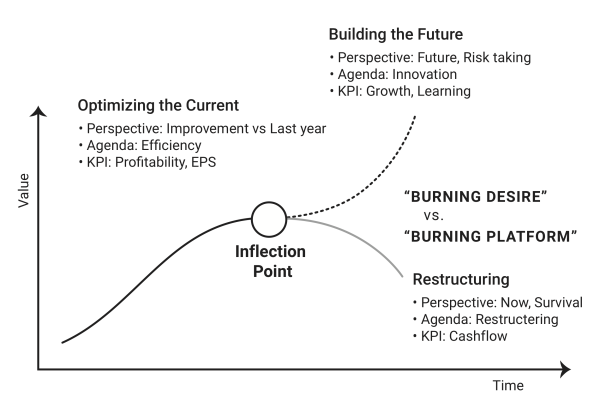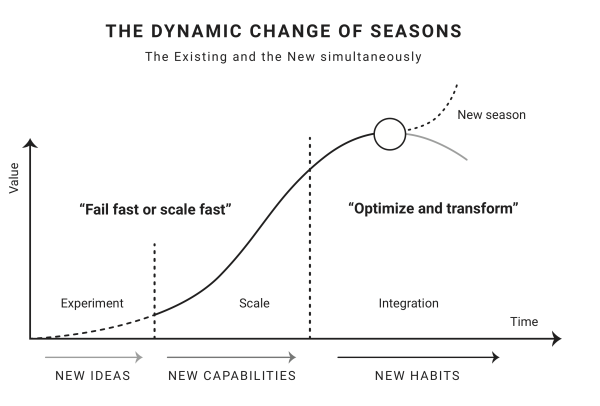And What You Should Do Instead
By Mikael Trolle (CEO & Co-Founder of IDONEA)
and Tjorven Ludes (Marketing Coordinator of IDONEA)
In times of radical change, not taking a risk is actually the biggest risk you can take!
Jim Hagemann Snabe Tweet
What may sound counterintuitive at first makes a lot of sense on second thought.
According to McKinsey and Innosight, within the last 20 years alone, the average age of S&P top 10 has decreased by more than 50 years. The average tenure as an S&P 500 is projected to sink to just 12 years by 2027, drastically less than the over 30 years in the 1960s. And the turnover rate on these rankings is only increasing. These eye-opening projections result from the fact that the world is changing ever faster, driven by a rapidly increasing frequency and impact of technological developments and innovation.
When change has become the constant, quickly shortening the longevity of businesses, leaders and their organizations can’t afford complacency anymore. So in this article, we’ll tell you all about:
- Why it’s the case that not taking risks poses the highest risk
- How you can avoid that trap
- How to decide which risks are worth taking
Along with that, we’ll equip you with some actionable advice and suggestions throughout.
The Cost You Don’t See… Until It’s too Late
The tricky thing about the cost of not taking risks is that it’s a cost you don’t generally see – at first. And that is because it’s the opportunity cost: It’s the potential benefits you and your organization miss out on when choosing one alternative (not taking certain risks) over other potential opportunities (involving certain risks).
The case with opportunity costs is that they are – by definition – unseen since they are not directly apparent as the potential profits of a neglected alternative. So, there’s a good chance you may not be aware of them. But here’s a little spoiler: Later on, the cost turns into your organization’s business vitality or extremely challenging conditions for a reinvention.
So, what’s the opportunity cost of not taking risks? Simply put, it’s development.
Without taking risks, without taking chances on new and emerging technologies, business models, or new markets – without all that, your organization won’t progress, develop new capabilities, and adapt to a changing business environment. In short, without taking risks, you won’t innovate. That’s because innovation is always inseparably tied to unpredictability and uncertainty. And when outcomes are unpredictable, you automatically take a risk by being required to take bets on the future.
But what would be the alternative? That would be to plan your company’s future meticulously right down to the last details with an exhaustive business plan – which would grant you peace of mind and a sense of control over the future.
“And what’s wrong with that?” one may ask.
This sense of control is just a false reality. In actuality, the world around us – including our business environments – is changing so fast and so drastically that you simply cannot predict what your business environment will look like in 5 or 10 years, much less in 15 or more! So while you may reach your meticulously planned goals in 5 or 10 years, the world and your industry may have changed so much that what you have planned for has become irrelevant. Your business may have become irrelevant.
Without experimenting on changes and developments that may benefit you in the future, you take the risk of being outpaced by your (current or soon-to-emerge) competitors. And while your current opportunity cost is development, innovation, and progress, that cost turns into your organization’s business vitality in the future. Or at best into extremely tough circumstances for a reinvention because your organisation is too far down the road of irrelevance already.
So what should you do instead? Risk management is not about avoiding risks but about taking calculated risks. Let’s take a deeper dive into this.
How to Know What Risks to Take And When
The fundamental premise is: Don’t wait until your business is falling off a cliff to start making those changes that should keep it relevant and thriving in the future. Don’t be complacent when your business is thriving. Reinvent your business from a position of strength.
Only when your business enjoys a position of strength will you have the resources (e.g., financial but also personnel-wise) and room to experiment safely without having the organization’s livelihood immediately depend on it. Your position of strength gives you the safety and protection you need when taking risks: It allows you to ‘minimize the risk in taking risks’. It makes sure that possible failure doesn’t mean the end of your business – as it may when you reinvent to stay alive.
The above implies that your goal should be to identify when it becomes time to start your transformation towards the future (your new season) and begin focusing on experimenting and taking certain risks that will allow you to stay relevant and successful as a business in your new season.
“If it ain’t broke, don’t fix it,” goes the saying. But what if that logic is wrong? Perhaps it would be wiser to say: “If it ain’t broke, consider fixing it.”
Mikael Trolle & Jim Hagemann Snabe (in the book "Dreams & Details")
Of course, it’s also not about diving head-first into any risk you can find. Not all risks are made equal; not all risks are “good risks”. It’s decisive that you evaluate the risks based on your best approximation of what the future may look like, how your industry and value chain may transform, and what consumer demands might change to.
For this, you’ll find signals in your market environment, both for when it is time to change but also for what change may look like, which risks may be the ones worth taking. Let’s go through some of our recommendations about the “when” and “what” step by step.
The Three Approaches to (Season) Change
There are three different manners in which you can start the transformation of shifting from optimization of your existing business (your current season) to experimentation and innovation. That transition from your current to your new season is what we call “Season Change”.
- The Reactive Approach: In this approach, you react when it’s too late – when you’re encountering a burning platform. You experience the signals of a lack of growth or even declining profitability, a restructuring project, unexpected new competitors outpacing you quickly, or other obvious signs for a drastically changing business environment. At this stage, you’ll see a reinvention of your company as the only possible solution as the way out of a fast-approaching crisis, but you’ll have it extremely difficult to succeed due to a lack of resources.
Needless to say: This is the approach you want to avoid. This means you’re already falling off a cliff; you’re on the way to becoming irrelevant. - The Active Approach: Although the signals may be harder to detect at this level, they are there. While your business performance may look healthy with satisfactory profitability, there could be signals of your relevance-curve having topped already and facing down. These signs include limited revenue growth for some time, meeting targets by optimizing rather than new growth, or even by cutting costs to defend profits.
This approach of searching for signals allows you to react to the major, upcoming changes still somewhat early enough to prevent your organization from falling off a cliff. However, it won’t enable you to take advantage of new opportunities before your competitors, to be really innovative and potentially disruptive. You’ll go with the flow, but you most likely won’t be a disruptor or market leader. - The Proactive Approach: At this level, you’re actively scouting and looking at your own and the adjacent markets and expect changes. You’re constantly putting out your feelers to explore what kind of dangers as well as opportunities lie ahead of you. You’ll inquire your employees to report what they see happening and listen to their improvement suggestions and new imitative proposals. To make the necessary changes you don’t just look at your own industry, but you’re ready to learn from other industries. You know that optimization is important and – in fact – the foundation for your reinvention. But you also know that a cyclical reinvention is inevitable, and you’re ready to start the transformation when you uncover the hidden signals.
With the proactive approach, the ultimate goal is to identify inflection points (= the point where the lifecycle curve of your organization has reached its pinnacle and is about the decline) early. This allows you to find new emerging opportunities, experiment, and innovate before your competitors, and ultimately take the lead in changing or new markets.

But how exactly do you follow the proactive approach, to identify the next inflection point? How do you know it’s time to start the reinvention process and which risks are worth taking?
The Art of Asking the Right Questions: Our Recommendations to Help You
Fundamentally, it comes down to challenging the status quo and the assumptions you’ve always taken for granted. Now, this can be very tricky since you’re usually not aware of the assumptions you’re never questioning. But becoming aware of your basic assumptions and challenging them on their current validity is the point of departure for finding out when it is time to start the reinvention as well as what to experiment with to prepare for the new season. It’s about finding out your unknown unknowns.
There are known knowns. These are things we know that we know. There are known unknowns. That is to say, there are things that we know we don't know. But there are also unknown unknowns. There are things we don't know we don't know.
Donald Rumsfeld
“What if?” becomes the most relevant and most fundamental question. What you’re trying to figure out is: Where are the markets of tomorrow? How do we become leaders in future growth markets? What is the biggest wrong assumption we have in our company or on our team concerning how we think the future will look like and what our role is in that future?
You’ll get there by asking the right questions and being brutally honest and realistic about the organization and its situation. The questions can be grouped into different categories:
1. Regarding Your Market Environment (Market, Value Chain & Competitors):
Here is a range of questions regarding your addressed market, and your position in it, your industry, value chain, and competitive landscape:
- Your Competitors: Search the market for small, new businesses with high growth rates that challenge assumptions in the industry. What assumptions do the new players in the industry have? What assumptions have they challenged? What problem are they solving, and how is their solution different? Do they provide customers with something we cannot?
- Your Current Market: You have to look at the market from a wide angle. What is changing? Are customers expecting something new? What is your share of wallet: How much of the customers’ total spend within your category of goods and services can you really capture with your offerings? In contrast to market share, where you compare your size with competitors, share of wallet tells you how important you are to your customer.
- Your Future Market(s): Where and what are your future markets? Which markets are currently developing or experiencing strong growth, where you’d bring the essential prerequisites and competencies/capabilities (where you could build on) to enter and possibly capture the market or increase your share on that market? Where do you have a chance of becoming a market (or market-segment) leader?
- Your Value Chain: Understand the current value chain and project where it is going: Will the value chain change and if so – which parts of the future value chain offer the highest profitability? Which parts will be squeezed by new technology or players?
2. About the Inside of Your Organization:
How is your employee engagement? Your front-line employees are the closest to the customers, so they should be your eyes and ears when it comes to changing customer demands. Declining employee engagement could be a sign of decreasing relevance of the product and increasing dissatisfaction over the conditions of the company. But you don’t want to let it come to that. Be proactive and ask them, have them report what they see, and propose improvement initiatives.
And how about your company culture? Are your company’s history and culture so stagnant that it may be blocking change, development, and innovation? Is there a change bias, a deep-rooted reluctance to change?
3. About Your Other Stakeholders:
How are your other stakeholders reacting to the direction that you’re going? How do your customers, business partners, and investors view the company? And what assumptions do they have for the future?
4. About Tech Developments:
Which new, planned, or developing technologies are likely to change the fundamentals of your industry? What’s their potential impact on your company’s assumptions, the value chain, customers, and your business model? Project an exponential development and assess its impact on current assumptions and business models.
How to Practically Approach it
All these questions may sound like a lot now. But asking and answering them is a necessary and crucial step on the way to figuring out which risks you should take to stay relevant and ahead of your competitors in the future.
As a business leader, perhaps take some time to go through the questions yourself first. See what you come up with.
But importantly, make sure to take it to your (leadership) team as well. Go through the questions together and discuss! After all, the discussions, analysis, well-founded guesses and expectations, reflections, and ideas all together are the foundation to figuring out your optimal strategic direction for the future.
Here is some additional practical advice for approaching these questions from the “Dreams & Details” book:
- Imagine and envision future scenarios for your company, analyze trends and consider possible versions of the future. Draw out different paths of how your business environment (the world, society, customers, tech, value chain, etc.) may change and how your business would be impacted in each of these scenarios. Consider also how likely each scenario would be and what it would require from your company to adapt.
- Envision being a new competitor entering your market with unlimited resources. How would that competitor look at the market? How would they try to outcompete you? Which technologies would they use and how? That may help you see your business from a different angle and identify previously overlooked weaknesses and possibilities.
- Look at adjacent industries: What changes are happening there, and how could they affect you? How can you learn from other, possibly already disrupted industries to make sure you’re better equipped to handle change? What can you take from other industries and apply to your own (e.g., in terms of innovation or business models)?
Based on these questions and the fruitful discussions arising from them, decide what your next steps should be. Is it time to optimize your existing business, or are there signs of a new season on the horizon? Determine your few crucial details (your must-win battles) for the future.
What to do next – what kind of environment you have to create to succeed with continuous development and cyclical reinventions – that’s what the next section will tell you all about.
Fail Fast or Scale Fast
To achieve continuous success in a fast-changing world, companies have to master the ability of being able to optimize their existing business while at the same time developing and experimenting for their new season. Even if you have a dedicated R&D department to experiment with ideas for the future, input for these experiments should come from the entire company, as well as from outside the company.
What’s immensely important, though, is that you create a culture in which it is allowed to fail and where honesty and constructive discussions (also about failure) are not just okay, but even highly valued! The underlying premise of your approach to experimenting for the new seasons should be: “Fail fast or scale fast.“

And it’s important to understand the following: Without having experiments that fail, without taking certain risks that may not pay out, you most likely won’t be able to find those new ideas and solutions that you can develop and scale into your new capabilities, and which will be the foundation of your new season and future business success.
So, try and experiment while investments are small, and find out fast which paths are worth following and investing in and which ones are dead ends. This takes the stress out of failing and turns it into learning moments instead. And by keeping focusing the risk of failure on your experimentation phase, you keep the risk as small as possible.
The most difficult job during the experimentation phase is choosing what experiments to prioritize for the new season. Usually, not all experiments can be included in the new season, so in many ways, it becomes a process of deselection. It takes courage to pick specific experiments and gamble on their success and even more courage to reject and stop projects. But it is vital to change seasons effectively.
A change of season finally occurs when the right ideas and projects are scaled, and the new details (capabilities and competencies) are developed and become part of the existing business – that’s how the company reinvents itself.
Ideally, you seamlessly transition to the reinvention towards the future while building on the optimization of the existing business in accordance to the stage of the lifecycle curve you identify yourself on. That’s what we call the dynamic change of seasons.
Last but not least – drawing a line to the beginning – here’s our final bit of advice to get your journey towards your new season started, to help you figure out what your best path forward is and which risks may be worth taking. Simply ask yourself this: “What is the risk of not investing in something new?”
Would you like us to help you figure out which what your new season could look like, and which risks you should take to succeed?
Feel free to browse our services or contact us directly for chat about how we could help you best.





